railway-international.com
05
'23
Written on Modified on
Sustainability in Railways and Freight Transport
Milton D’Silva on how railways around the world are facing electrification and other challenges in quest of net zero.
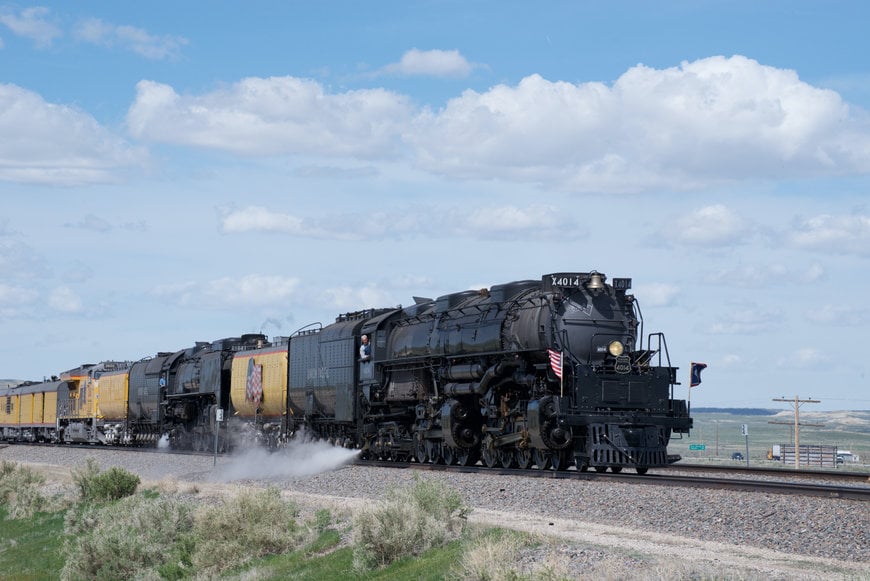
If the wheel is the greatest invention of mankind, then the tracks and rails are not far behind. Historical evidence suggests that constructed trackways existed as early as around 3838 BCE. Later records prior to the Common Era show the existence of paved trackways in Greece that were used for transporting boats across the Isthmus of Corinth in Greece from around 600 BCE. Wooden rails came much later in the Sixteenth Century, the earliest example dating to the year 1515 of a funicular railway at the Hohensalzburg Fortress in Austria. The line originally used wooden rails and a hemp haulage rope and was operated by human or animal power, informs Wikipedia. This was the norm then, of various types of railways that existed, mostly in the area of mining, to haul coal or mineral ores over considerable distances, pulled by humans or animals, mostly horses. The underlying idea was always the same – faster travel with relative ease over long distances.
The history of modern railways is relatively recent and can be stated to have begun with one of the most iconic developments of the Industrial Revolution – the steam engine. Several versions of steam engines were developed from the mid-17th century, mostly for reciprocating movement. However, it was with the one with the rotary movement put together by James Watt in 1763 that the evolution of the steam engine truly began as a workhorse, first for powering industrial machinery, and then transport. According to Wikipedia, the first occasion on which a railway locomotive pulled a train carrying passengers was in 1804 at Penydarren Ironworks in Wales (UK), when 70 employees of the ironworks were transported 9 miles by an engine designed by Richard Trevithick. At that time, there was a regular passenger rail service with a horse drawn train on the Swansea and Mumbles Railway in the UK, but soon that was to change forever. For the first time in human history, waterways had an economical substitute for carrying passengers and cargo on land.
An economical mode of transport
‘Economical’ is the operative word when it comes to railways as a mode of transport for freight or passengers. It typically refers to the cost-effectiveness and efficiency of this mode of transportation, compared to other options. Rail transport has several characteristics that make it economically advantageous:
Bulk transportation: When it comes to transporting bulk goods or carrying huge loads over long distances, railways are particularly efficient. In the UK, the early railways, e.g., the Liverpool to Manchester line, were built by the Act of Parliament on demand by the citizens. Factory owners wanted a cheaper and more reliable mode of transport than waterways, which were not operational during the whole year. Raw materials and finished goods transported by railways could reach other towns and ports faster and cheaper, resulting in wider reach and better profits.
Fuel efficiency: In general, trains are more fuel-efficient than most other modes of transportation, in particular, over long distances. While ocean freight is cheaper on sheer cost, for landlocked countries that is not an option; when compared to air or road movements, railways are miles ahead on the path to fuel efficiency. Moving on dedicated tracks, there are no traffic jams that lead to wastage of fuel on roads.
Dedicated infrastructure: Unlike road transport where there are multiple lanes and different routes to the same destination, railways run on dedicated tracks and usually follow the shortest route to the destination, the tracks built to surpass obstacles with the help of tunnels and elevated rails. Together with the railway stations and yards built for cleaning and servicing of the trains, the rail network once established can be used for a long time with relatively low maintenance costs. This leads to economies of scale, as the cost per unit of distance or volume decreases with increased utilisation.
Reduced traffic congestion: Clogged roads due to heavy traffic conditions, whether inner city or intra-city, not only delay movement but also add to the overall inefficiency. Stalled and slow moving traffic wastes fuel and directly contributes to increased emissions. Railway trains do not face this problem as they move masses of people or tonnes of freight. This contributes in no small measure to reduced road maintenance costs and decreased environmental impact associated with road transportation, which is powered by fossil fuels. In city travel for passengers, metro trains replace thousands of passenger cars on the city roads. For long-distance travel, railways are a very competitive mode of transport compared to other forms of road transport or flights.
In general, besides being economical, rail transport is more environmentally friendly compared to other modes of transportation, particularly when it comes to greenhouse gas emissions per freight- or passenger-mile. Interrail, the railway travel portal of the European Union, goes to some length to show how the train is one of the cleanest ways of commuting, especially on longer distances. Compared to cars and airplanes, trains consume little energy and emit a lot less greenhouse gases – between 66 and 75 percent fewer carbon emissions. Flying, for example, emits on average 6 times more greenhouse gases than a high speed train. The Interrail Pass is a very convenient way to travel by train in Europe, for daily, frequent and infrequent travel, with a lot of options.
While the economic benefits of railways as a people carrier are obvious, for movement of freight, there are factors other than cost that may come into play when deciding the mode of transport. These include the specific type of goods being transported, the distance involved, and the existing infrastructure. The biggest disadvantage of railways when it comes to hauling of freight is the last mile connectivity which is easier for passengers but highly inconvenient for goods. Sometimes cargo consignments are required urgently and cannot wait for movement by train, in which case they are best dispatched by road. Some cargo is highly sensitive for movement by train or road and may have to be sent by air.
It is important to note that the environmental benefits of railways can vary depending on factors such as the type of train (electric or diesel), the source of electricity, the efficiency of the railway system, and the specific characteristics of the route. Additionally, continuous efforts to improve efficiency and reduce the environmental impact of railway operations contribute to the overall environmental friendliness of rail transport.
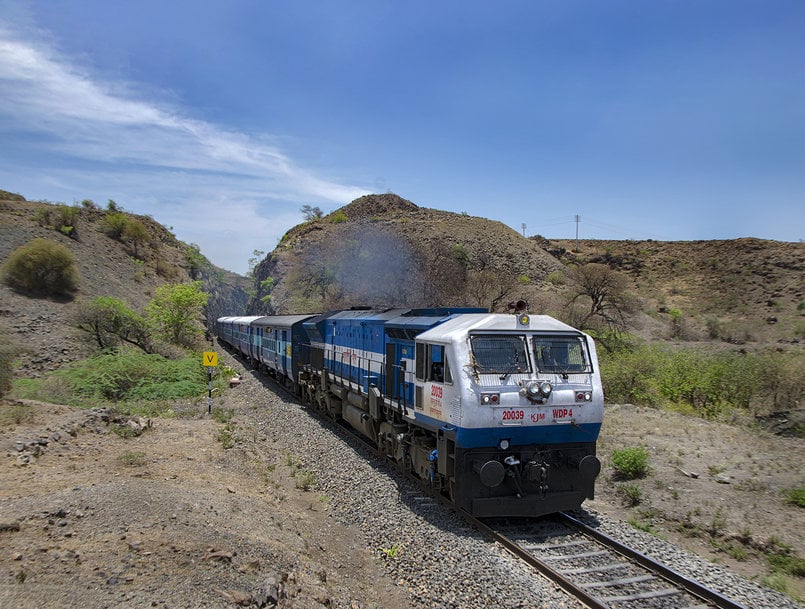
An express train climbs to the end of the gradient across a mountain pass in India – the country with the fourth largest railway network in the world. Photo Credit: Apurva Bahadur
Railways and sustainability
The reasons that contribute to making railways economical are also the reasons that make it sustainable as the world is striving to achieve the net zero goal. According to the International Energy Agency, railways is one of the most energy-efficient transport modes, responsible for 9% of global motorised passenger movement and 7% of freight shipping – but only 3% of transport energy use. Railways use 80% less energy than trucks per tonne of freight carried and enjoy a four-to-one advantage over cars in terms of emissions intensity. As a result, rail accounted for just 4% of the transport industry’s global emissions in 2019. Given these statistics, the environmental sustainability of railways is much higher than any other mode of transport. Yet this is not the success story it appears to be on the sustainability front for two reasons. One is the railways still consume a large amount of fossil fuel with the diesel and diesel-electric hybrid engine, with electricity from non renewable sources also contributing to the carbon footprint. The second and more important factor is the still unexploited potential of railways to gather an incremental share in both passenger- as well as freight-traffic across the world.
At this point it would be of interest to note how the debate over sustainability of the railways progressed over the last few decades. Concerns over the environment began as early as in 1949, when the UN Scientific Conference on the conservation and utilisation of resources became the first UN body to address the depletion of natural resources and their use. In 1972, the UN Scientific Conference, also known as the First Earth Summit was held in Stockholm. It adopted a declaration that set out principles for the preservation and enhancement of the human environment, and an action plan containing recommendations for international environmental action. In 1988, global warming and the depletion of the ozone layer became increasingly prominent in the international public debate and political agenda. In 2014, the International Railway Association (UIC), an international rail transport industry body with 240 members across 100 countries worldwide, proposed a transport sector challenge in the framework of the green growth agenda and climate change perspective for 2030 and 2050. This challenge sets out ambitious but achievable targets for improvement of rail sector energy efficiency, reductions in greenhouse gas (GHG) emissions and a more sustainable balance between transport modes. The idea was to reduce energy consumption and carbon emissions by setting definite targets:
1. Reduction in specific final energy consumption from train operations (relative to a 1990 baseline): 50% reduction by 2030 and 60% reduction by 2050.
2. Reduction in specific average CO2 emissions from train operations (relative to a 1990 baseline): 50% reduction by 2030 and 75% reduction by 2050.
The UIC evisages to achieve these targets by railway companies across the world through electrification of existing lines, decarbonisation of electricity supply, improving load factors, procurement of more efficient rolling stock, energy management systems and efficient driving.
Electrification of Railway Lines
The early trains were hauled with steam engines and later the diesel-mechanical engines. Subsequently the diesel-electric engines in various versions were introduced, where the traction was by electric motors fed by electricity generated by diesel engines. Railway electrification was a later development where trains are powered by electricity instead of diesel or steam power. The origins of rail electrification can be traced to the late 19th century when electric tramways were introduced on either side of the Atlantic Ocean, in New York and London. The mainline railway route was electrified in the US in 1896. But despite this early start, today just about one-third of the global railway network is electrified. This is mainly on account of the high cost of electrification, especially in regions where low volumes of traffic – passenger or freight – make investments hard to justify. As a result, in North America the percentage of electrification of the railways – at just about 1% – is abysmally low, whereas it is around 60 percent in Europe and Asia on an average. The US is a typical example of the poor electrification process. Though the country boasts of the largest railway network in the world with 250,000 km, only about 5000 was ever electrified at the peak, which was in the 1930s and it has progressively come down since then. This, when the reality is diesel-powered trains transfer only about 30-35 percent of the energy generated by combustion to the wheels, while supplying electricity directly from an overhead powerline transfers about 95 percent of the energy to the wheels.
Ironically, it is the Association of American Railroads that opposes electrification due to its high capital costs. But as Michael Barnard, Climate Futurist advising multi-billion dollar funds and firms says, sooner or later the US will have to follow the rest of the world in rail electrification or watch its already diminishing share of freight fall further with road freight eating its market share. In comparison, Barnard cites electrification statistics from other countries including India which has electrified above 85% of its heavy rail and is aiming for 100% by 2025. China is at 72% and building more electrified, high-speed freight and passenger rail rapidly. Europe is at 60% and climbing. As of March 2003, 55% of Japan's conventional rail line was electrified with 100% of the high speed Shinkansen or Bullet Rains. The entirety of the storied Trans-Siberian Railroad, all 9,300 kilometers of it, is electrified.
At 68,525 km, India has the fourth largest network of railways in the world behind the US, China and Russia. However, in terms of electrification, almost 100% of its broad gauge network totalling about 65,000 km is electrified. What is even more impressive is the statement made by Prime Minister Shri Narendra Modi at COP26 Summit in Glasgow in 2021 to make the Indian Railways 'Net Zero' by 2030. However, it is important to understand that mere electrification of railways does not make it zero emissions and that can happen only when 100% electricity used to run the network is renewable. So to make a real difference from the sustainability perspective, the electrification of railways must proceed in tandem with the decarbonisation of electricity.
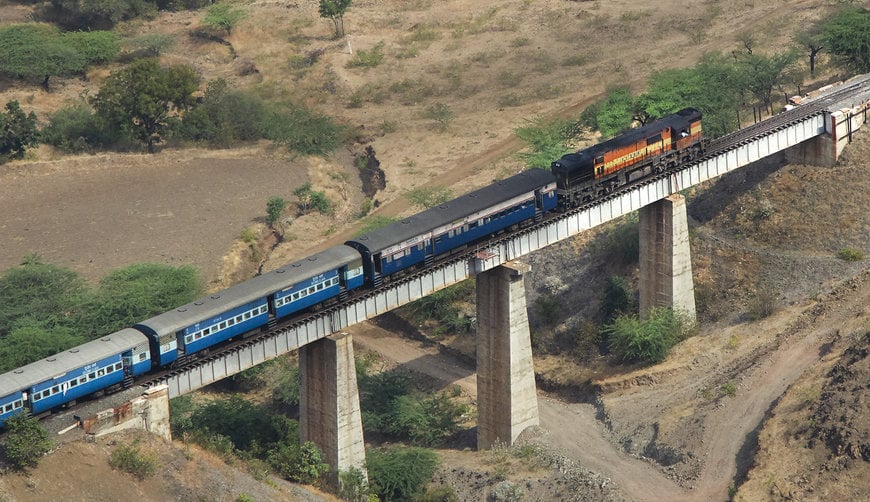
A diesel engine hauls a passenger train across Viaduct3 of Shindwane Ghat, India. Photo Credit: Apurva Bahadur
The hydrogen alternative
Hydrogen fuel-cell propulsion is often touted as an economical alternative to electrification with all the attendant benefits. Is hydrogen a cost competitive alternative to electrification? Not at the moment with existing technologies, though there is a strong hydrogen lobby that believes otherwise. Efforts to use hydrogen to power trains had begun in the US since 2003, but it is still not cost competitive on energy efficiency compared to using electricity from the grid. In fact the German State of Lower Saxony that launched the world’s first H2 Line in 2022 with 14 hydrogen fuel-cell trains has decided not to go ahead with the conversion of the rest of the trains. Instead it is opting for battery-electric trains that are cheaper to operate.
This does not mean there is no future for hydrogen powered trains. In fact in Italy, FNM, the leading integrated group in sustainable mobility in Lombardy, recently presented, jointly with the manufacturer Alstom, the hydrogen-powered Coradia Stream train that marks the beginning of a new era in passenger rail transport in Italy. The event was held as part of EXPO Ferroviaria 2023. According to a press release issued by Alstom, the train will enter commercial service in Valcamonica between the end of 2024 and the beginning of 2025. The hydrogen-powered Coradia Stream meets the European target of reducing CO2 emissions by 100 percent by 2050 and is the first zero direct CO2 emission train for Italy equipped with hydrogen fuel cells, with a total capacity of 260 seats and a range of more than 600 km.
Siemens Mobility has also recently completed the first test runs with the Mireo Plus H hydrogen-powered train in Bavaria, Germany. The two-car train set will enter passenger service in mid-2024 on routes between Augsburg and Füssen and Augsburg and Peissenberg on the rail network of Bayerische Regiobahn (BRB). Pilot operations of the train are planned for 30 months and are supported by the State of Bavaria, pursuant to the development partnership agreement signed by the two entities in 2021. “Partnering with the State of Bavaria, we have reached an important milestone for the future of alternative drive systems for trains. Our hydrogen-powered Mireo Plus H train will operate completely emission-free between Augsburg, Füssen and Peissenberg. With this train, we are offering a sustainable solution for rail routes that are not electrified,” said Karl Blaim, Managing Director and CFO of Siemens Mobility, on the occasion.
Other major vendors too are on the job. Hitachi Rail is developing battery powered trains that can switch seamlessly between overhead power, onboard batteries and diesel. These will provide cleaner air in stations and city centres without the need for cost-prohibitive electrification in tunnels or over bridges. Hitachi is also investing in Hydrogen Fuel Cell powered trains. The test trains are being developed with Toyota and East Japan Railway Company. They will use a hybrid drive system and storage batteries developed by Hitachi, incorporating hydrogen powered fuel cells from Toyota.
Similarly, China’s state-owned railway company China Railway Rolling Stock Corporation (CRRC), unveiled in mid-June 2023 Ningdong. According to the company it is the world’s most powerful hydrogen-powered locomotive with capacity to run for up to 190 hours and takes two hours to refuel its 270kg capacity of liquefied hydrogen. Sources say the Ningdong engine has been converted to hydrogen power from a diesel engine locomotive, in a joint effort between the CRRC Changchun Railway Company and Chengdu Rail Transit.
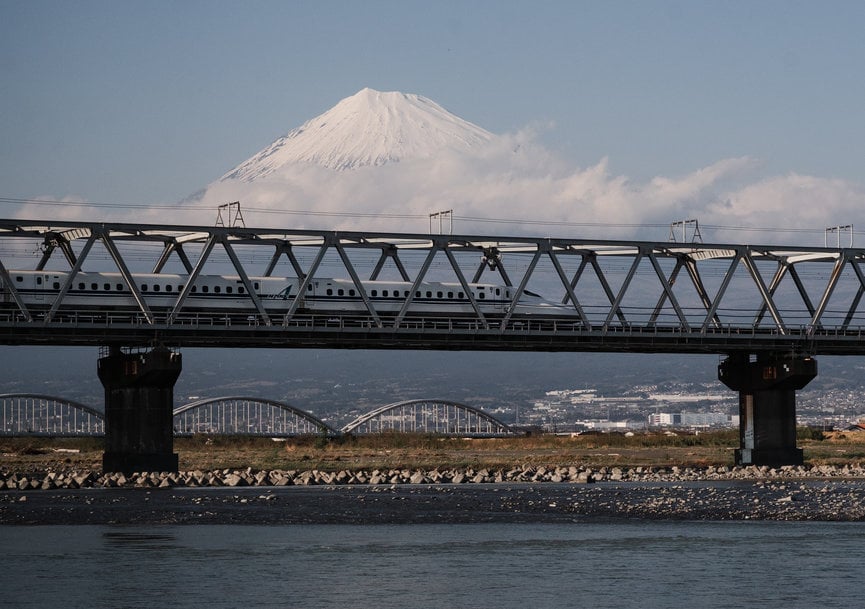
The legendary Shinkansen – the Bullet Train – of Japan crossing the Fuji River against the scenic backdrop of Mount Fuji. Image by wirestock on Freepik
Major Vendors of Railway Systems & Technology
Several major vendors globally provide railway systems and related technologies. Some of the key players in the global railway systems market include:
Siemens Mobility: Siemens is a major player in the railway industry, providing a range of solutions, to shape contemporary and future passenger and freight transportation. The offerings include trains/rolling stock, infrastructure, automation and electrification solutions, signaling systems, turnkey systems as well as related services. That covers trams, light rail, metro, commuter and regional trains, high-speed and very high-speed trains.
Alstom: A French multinational company, Alstom claims to be a global leader in the transportation sector, in the digital age. From high-speed trains, metros, monorails, trams, to turnkey systems, services, infrastructure, signalling and digital mobility, Alstom offers its diverse customers the broadest portfolio in the industry. The company has a presence in 63 countries with a talent base of over 80,000 people from 175 nationalities.
ABB: Switzerland-based provides innovative solutions that contribute to sustainable and smart mobility. ABB has a long history of providing innovative and energy-efficient technologies to the rail sector, manufacturing and servicing all components and subsystems in urban, intercity and high-speed networks for rail infrastructure and rolling stock. The company also provides life-cycle service support, including retrofits and maintenance for its large global installed base.
CRRC Corporation Limited: Based in China, CRRC is one of the largest manufacturers of rolling stock and railway equipment globally. CRRC undertakes design, manufacture, testing, commissioning and maintenance of locomotives and rolling stock, including: electric locomotives, diesel-electric and diesel-hydraulic locomotives from 280 kw to 10,000 kw for mainline and shunting duties; high-speed trains of speed over 350 km/h; DMUs and EMUs for urban, suburban and regional transport; trams and light rail vehicles; metro cars and passenger coaches; as well as full line of freight wagons.
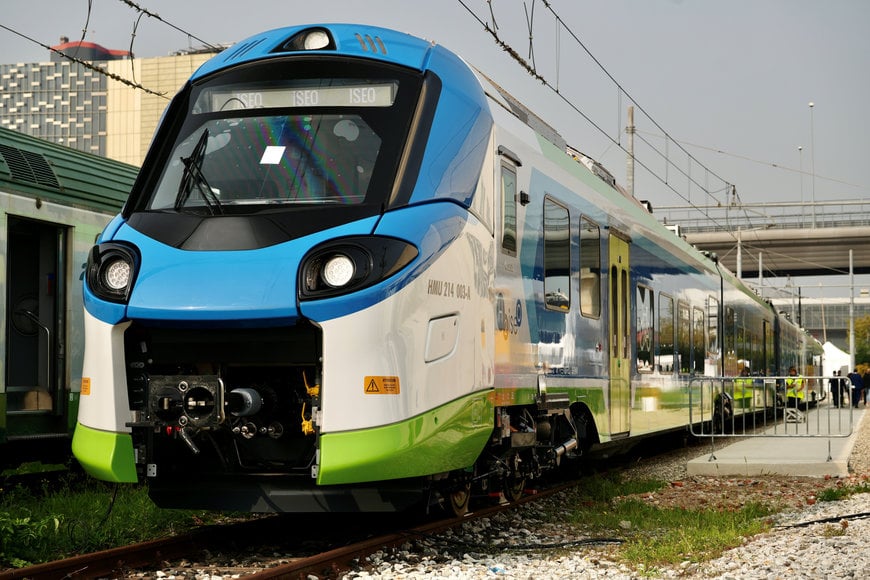
The Alstom Coradia Stream train marks the beginning of a new era in passenger rail transport in Italy. Photo source: Alstom
GE Transportation: General Electric Transportation (now part of Wabtec Corporation), has revolutionised locomotive engine design and performance with physical breakthroughs in combustion, electric power and advanced materials. Today, the company is leading the digitisation of locomotives and the rail network itself, bringing digital horsepower to enable operations at increased speeds and efficiencies of trains on the track. In recent years, the company has led the development of digital platforms like Trip Optimizer, Movement Planner and Railyard Planner. These platforms have given rail customers digital oversight and the ability to optimise the movement of individual locomotives to entire fleets along their networks.
Thales Group: Thales is a multinational company that provides various solutions, including signaling systems, communication, and control systems for the railway sector. The company provides systems to highly demanding national, regional and international rail networks located on every continent. Customers benefit from improved availability, increased capacity, and better predictability and punctuality, resulting in a more appealing overall experience for passengers. Thales digital technologies are serving the rail industry in all major activities: autonomous train & metro; connected infrastructure for predictive maintenance; data-driven decision support;
AI-based security solutions; next generation ticketing; and digital platform to Support as-a-Service business models
Hitachi Rail: A division of the Japanese conglomerate Hitachi, Hitachi Rail is involved in the manufacturing of rolling stock and railway signaling systems. It is a global company which has delivered railway products as their core business for over 100 years. This ranges from metro, commuter and high speed rolling stock through traffic management, traction and signalling solutions. Hitachi also offers the regenerative energy storage system that saves energy by storing reusable power generated when electric trains decrease their speed in storage batteries and using the stored energy during acceleration. The stored power can also be used to propel trains in an emergency.
Mitsubishi Heavy Industries: This Japanese company engaged in diverse business activities has been manufacturing conventional railway vehicles, including steam locomotives and electric locomotives, since 1910. Starting in the 1970s, MHI began the development of diverse transportation systems, notably new transit systems such as the rubber-tired Automated Guideway Transit (AGT) system. The Crystal Mover range of AGTs is used to transport passengers between terminals and between airports and surrounding buildings. The company is also engaged in development of High-speed Railways (Taiwan)/Overseas Metro Systems (Dubai).
Hyundai-Rotem: A member of Hyundai Motor Group (HMG), Hyundai-Rotem has supplied various types of railway vehicles, including EMUs, high speed trains, LRVs, DMUs, locomotives, and passenger coaches and freight wagons, to 36 countries across the world. It has localised the core electrical equipment of railway vehicles including train control management systems (TCMS), traction motors, propulsion systems, and auxiliary power units. Hyundai Rotem has expanded its business to integrated railway systems business, which includes signaling, communications, electricity, PSD system and aftermarket rail services such as rolling stock maintenance, modernisation and parts & repairs.
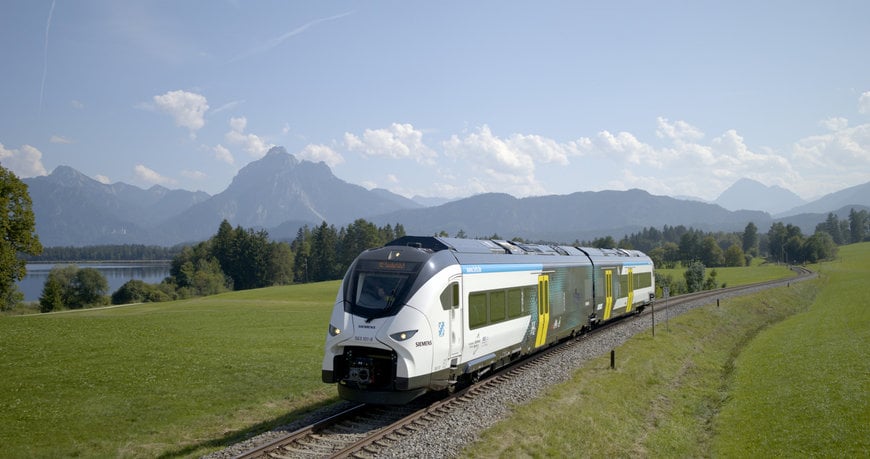
Siemens Mobility completes first test runs with hydrogen train in Bavaria, Germany. Photo source: Siemens
Conclusion
Despite the periodic oil shocks, the world remained addicted to fossil fuels. But the seriousness of the consequences of global warming and the grim scenario looming ahead is finally beginning to stir humanity into some collective action. Now it appears governments across continents are considering solutions that common sense failed to embed into policy-making earlier, especially in areas of cleaner transport options. As a result, railways are in a revival mode.
The Federal Railroad Administration (FRA) in the US recently announced a USD 1.4 billion investment for 70 rail infrastructure projects to be implemented in 35 states and Washington, DC. The authority says that this is the largest amount ever awarded for rail safety and rail supply chain upgrades through the Consolidated Rail Infrastructure and Safety Improvements (CRISI) programme.
Malaysia a while ago said it was seeking proposals from private firms to develop a high-speed railway between its capital Kuala Lumpur and neighbouring Singapore, reviving a multi-billion-dollar project called off more than two years ago.
Climate-conscious European governments and groups are going to varying lengths to break people of their flight habits, with France leading the way.
China and India, as noted in preceding paragraphs, are already high on the railway modernisation and expansion spree. Even the oil rich Gulf countries are adopting metro options for inner city movements. For once, there is hope better sense shall prevail.
References
1. https://en.wikipedia.org/wiki/Rail_transport
2. https://www.interrail.eu/en/plan-your-trip/sustainable-tourism-europe/why-train-is-best-option
3. https://www.forbes.com/sites/michaelbarnard/2023/11/24/most-rail-is-already-electric-and-all-will-be-even-in-north-america/
4. https://www.alstom.com/press-releases-news/2023/10/fnm-and-alstom-present-italys-first-hydrogen-powered-train
5. https://press.siemens.com/global/en/pressrelease/siemens-mobility-completes-first-test-runs-hydrogen-train-bavaria

